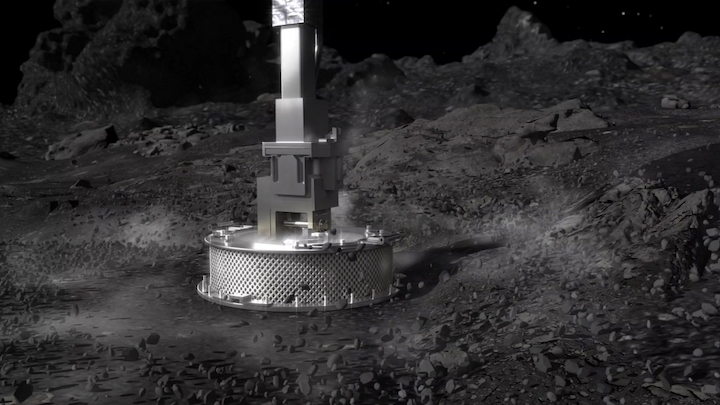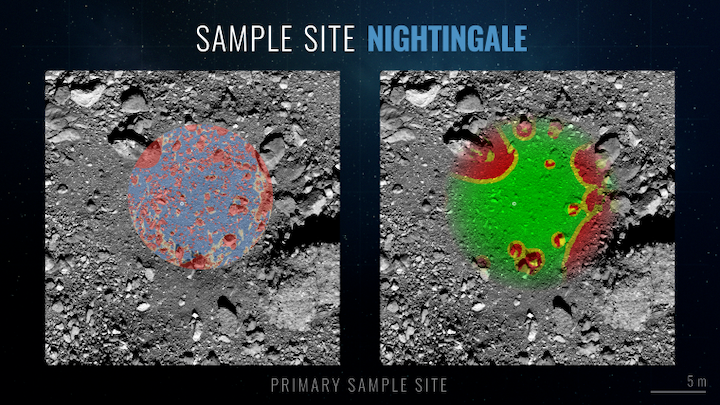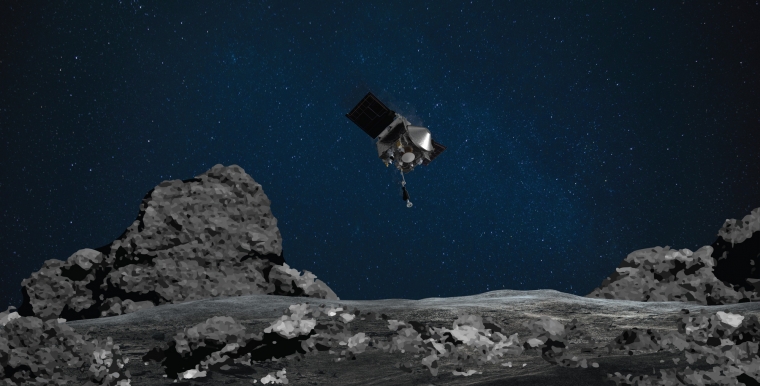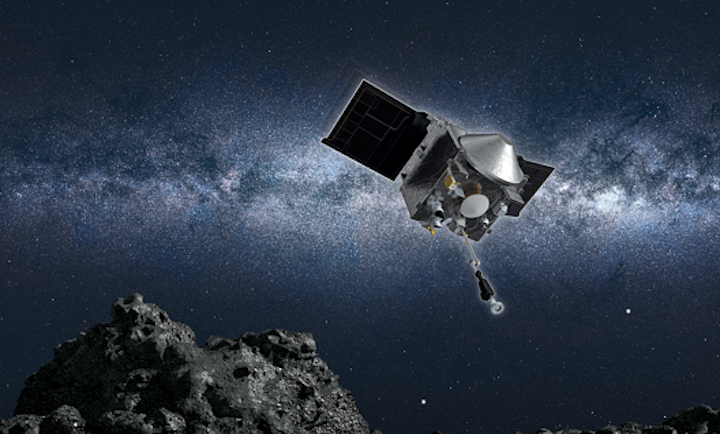19.10.2020
Why Scooping a Sample from an Asteroid is Harder than it Looks
Here's what will happen on Oct. 20, when NASA's OSIRIS-REx spacecraft will descend to asteroid Bennu and pick up a sample of pristine material left over from the formation of our solar system.

When NASA's OSIRIS-REx spacecraft descends toward the surface of Bennu on Oct. 20, it will be the first time that a U.S.-led mission attempts to pick up a sample of pristine material from an asteroid. Bennu is likely an extraterrestrial accumulation of the original leftovers from the formation of our solar system.
The University of Arizona-led mission to sample an asteroid many millions of miles from Earth is anything but a walk on the beach. As a matter of fact, Bennu "is not nearly the sandy beach we hoped and were expecting," said Thomas Zurbuchen, associate administrator for the Science Mission Directorate at NASA, during a Sept. 24 media event. Once the spacecraft moved closer and began sending back the first detailed images of Bennu's surface, it surprised the mission team and the public alike by revealing a rocky surface littered with house-sized boulders.
Since its arrival on Dec. 3, 2018, the OSIRIS-REx spacecraft has spent its time flying around the asteroid while scanning, photographing, measuring and studying the dark, rocky rubble pile below – from afar at first, then up close. Using its laser altimeter instrument, or OLA, combined with the data from images taken with the spacecraft's PolyCam instrument, the mission has produced maps of unprecedented detail, better than those of any planetary body visited by spacecraft. The mission's primary sample site, which sits inside a crater dubbed Nightingale, was selected based on those maps.
"We selected Nightingale because, by far, it has the most fine-grained material of all the four sample site candidates," said Dante Lauretta, the mission's principal investigator and a professor at the UArizona Lunar and Planetary Laboratory, during the press event. "We spent early 2020 doing low-altitude reconnaissance passes over this site, ultimately imaging at about an eighth of an inch per pixel. We basically have incredibly detailed images covering the entire crater, and we counted all of those rocks."
Shortly before 11 a.m. Arizona time on Oct. 20, thrusters on the spacecraft will fire and gently nudge OSIRIS-REx out of its orbit around Bennu and steer it down toward the rugged surface. That burn will set in motion a sequence of events that has been planned meticulously by the mission team.
What Happens if Everything Goes as Planned? And if it Doesn't?
Once the spacecraft has set off on the descent to its target, it will rely on what the mission team calls a "hazard map" – a detailed representation of areas within the sample site that may present a risk to the spacecraft due to the presence of large rocks or uneven terrain.
Just prior to touching the surface, the spacecraft will compare images from one of its cameras with the hazard map stored in the spacecraft's memory. If the descent path would result in the spacecraft touching down in a potentially unsafe spot, the system would automatically trigger the spacecraft to back away, a scenario that has a probability of less than 6% based on simulations.

If everything goes well, the spacecraft will extend its Touch-and-Go Sample Acquisition Mechanism, or TAGSAM, which is suspended at the tip of an 11-feet-long arm. Reminiscent of an air filter used in an older car, it is designed to collect fine grained material, but is capable of ingesting material up to about three quarters of an inch.
The sample will be collected during a "touch-and-go" maneuver, or TAG, during which the sampling head will make contact with Bennu's surface for around 10 seconds. When the spacecraft detects contact, it will fire one of three nitrogen gas bottles, and much like a reverse vacuum cleaner, stir up surface material – called regolith – inside the sampler head, before the spacecraft backs away.
As a backup, the sampling head features a series of small discs designed to pick up dust like sticky pads, in case something were to go wrong with the gas-powered sampling process.
The team will examine footage taken by the spacecraft's sampling camera, or SamCam, of the sampling head as it makes contact with the surface. SamCam is one of three cameras aboard the spacecraft that were built at UArizona.
"We'll be able to tell if we were tilted, if gas blew out to the side, if material was sufficiently stirred up," Lauretta said. "We also will have a very good indication of the exact location in Nightingale where we made contact and we can compare that to our samplability map, to assess if we touched down in an area where there is abundant samplable material or one of the rockier locations."
SamCam also will be able to take images of the sampling head after the spacecraft has departed Nightingale crater and is a safe distance from the asteroid. Because the sampling head is mounted on a wrist joint, the team will be able to examine it at a different orientations relative to the sun and the sampling camera. The team also will see any dust or material on any other area of the TAGSAM, on the arm or on the blanketing over the gas bottles, Lauretta explained.
"This will tell us whether we moved enough material around when we made contact, and maybe, just maybe, we'll be able to see some of the particles in the interior of TAGSAM, if the particles are in the right location inside the head and if we get the right illumination conditions."
After TAG, the team will then spend one week assessing how much sample was collected. It will use several methods to estimate the amount of sample, beginning with imaging the sample collection head for visual inspection. The team will also be performing checkouts of the spacecraft and instruments to verify that didn't result in degradation to either.
A Pirouette in Space
Next, the spacecraft is prepared to perform a maneuver designed to give the scientists on the ground an estimate of how much sample was collected. With its sampling arm extended, it will slowly spin around an axis perpendicular to TAGSAM to measure the change in mass attributable to the collected sample by comparison to a previous measurement taken with the sampling head empty.
Due to uncertainty in the technique, the result of the measurement needs to exceed the required sample mass to have high confidence that an adequate sample is present.

"We'll be looking for a 90% chance that we have 60 actual grams or more," Lauretta said. "Anything below that, we'll have conversations with NASA to assess the status of the spacecraft, its ability to go in for a second TAG, and to decide whether we want to return with what we have or go for a second TAG attempt."
The spacecraft can make multiple sampling attempts, as it is equipped with three bottles of nitrogen gas. For example, if it were to touch down in a safe location but failed to come up with a good sample, the team has developed contingency measures to ensure the mission still meets its primary science objective: collect at least 60 grams (just under 2 ounces) of surface material and return it to Earth.
"In case the decision is made we need to go in again, we have to get the spacecraft back into orbit and conduct a series of burns to line up its position in orbit for the next tag attempt," said Mike Moreau, deputy project manager at NASA's Goddard Space Flight Center in Maryland.
While Nightingale was identified as the best place to get a sample on all of Bennu, it still presents a lot of challenges, Lauretta said.
"By far, the most likely outcome we will have on Oct. 20 is we will contact the surface and came away with a large sample that exceeds our requirements. But Bennu has thrown us a number of curve balls already, which is why we are fully prepared to tag at Osprey (the backup site) if that becomes necessary," he said.
Once the decision is made to stow the sample, the team will proceed to place the head inside the sample return capsule and seal it for return to Earth in 2023. And when that time comes, chances are that it'll bring back even more than the minimum of 60 grams, as TAGSAM was designed to capture at least 150 grams, and under optimal conditions up to 4 pounds – enough to keep generations of researchers busy in laboratories on Earth.
Quelle: University of Arizona
----
Update: 20.10.2020
.
When the OSIRIS-REx spacecraft touches asteroid Bennu, it will capture NASA’s first sample from an asteroid and provide rare specimens for research that scientists hope will help them shed light on the many mysteries of our solar system’s formation.
The sample is scheduled for return to Earth in 2023 to be examined and stored in state-of-the-art curation facilities now under construction at Johnson Space Center in Houston. The labs will be managed by NASA’s Astromaterials Research and Exploration Science division, also known as ARES. The division is home to the world’s greatest astromaterials collections — including lunar rocks, solar wind particles, meteorites, and comet samples — and some of the experts who research them.
A long time coming
Scientists are eager to examine the sample from Bennu because it’s thought to be a relatively unchanged rocky remnant from the early days of the solar system. Studying the sample from Bennu could reve
al major insights about the formation and nature of the solar system, asteroids, and other small celestial bodies. In particular, scientists are eager to study the existence of water and organic compounds, such as amino acids in asteroids because such chemicals are known to be involved in many important processes, including the emergence of life on the ancient Earth.
However, in order to learn those scientific secrets, researchers must be careful to properly preserve, protect and handle what they expect will be between 3 ounces and 4.4 pounds (60-2000 g) of the pebbly surface of the asteroid, called regolith. To do so, ARES is developing new curation and research labs, cleaning facilities, tools, and asteroid storage areas that will allow researchers to study the material down to the molecular level without damage.
ARES began planning for the mission more than 15 years ago, and the curation effort is led by Kevin Righter, curator of the Antarctic meteorite collection at Johnson, which includes samples that may be similar to rocks from asteroid Bennu.
“After years of planning, archiving, launch, surveying, and now sampling, I’m a little on the edge of my seat to see what we collect compared to what we expected,” Righter said.
Righter is leading a team of asteroid curation scientists from ARES that includes OSIRIS-REx deputy curator Keiko Messenger, Nicole Lunning and Christopher Snead.
Something in return
In 2023, OSIRIS-REx will swing by Earth and release the asteroid sample in a capsule that will land in the Utah desert. There, ARES staff will be ready to safeguard the sample and prepare it for delivery to Houston. They’ll do the work inside a temporary clean room set up in a nearby aircraft hangar, just as ARES did after the Stardust comet sample capsule successfully landed in 2006.
Lunning is a scientist working alongside Righter during the initial processing of the asteroid sample.
“I’m really excited to see the sample and interact with it,” Lunning said. “Before it arrives, we’ll be preparing in many ways, such as holding sample return capsule retrieval and disassembly rehearsals to the make sure the actual event goes as smoothly as possible and the sample is protected.”
After landing, the sample will be transported to the new clean rooms at Johnson. There, Righter, Messenger, Lunning, Snead, and other ARES staff will conduct basic initial examinations of the sample to characterize, digitally catalog, prepare, and divide it for study by other researchers.
The first scientists to get a look at the Bennu sample will be a multi-institutional, multi-generational science team from the OSIRIS-REx mission that will study its chemical and mineralogic makeup, among other aspects, to complete the mission’s official scientific goals. After the first mission studies are finished, ARES will archive about 75% of the sample to be used in the future by researchers worldwide.
One international partner receiving a portion of the sample is the Japan Aerospace Exploration Agency, which in return is giving NASA a sample from its Hayabusa2 mission to the asteroid Ryugu. As part of the preparations, NASA is building a separate lab for the Hayabusa2 samples next to the OSIRIS-REx rooms so they can share commonly needed infrastructure, such as air handling systems and nitrogen storage environments. OSIRIS-REx deputy curator Keiko Messenger is also the curator of the Hayabusa2 collection.
The Canadian Space Agency, which contributed the OSIRIS-REx Laser Altimeter (OLA) instrument to the mission, will also be receiving some of the Bennu sample as part of this international partnership.
It’s the small things that matter
Scientists want to study the Bennu sample because the asteroid material won’t be altered by major events or processes that can affect meteorites, such as a fiery trip through our atmosphere or exposure to air or water on the surface of the Earth. Data from OSIRIS-REx also indicate that the rocks on Bennu are so fragile that they could not reach the Earth’s surface intact. That means ARES researchers need to develop techniques to carefully extract, handle, and examine the samples in ways that maintain its pristine state.
Snead is an expert on handling astromaterials down to the tiniest microscopic particles. A big part of his job is figuring out how to work with particles less than a millimeter in size so that scientists can learn more about the asteroid’s structure, chemistry, and the forces influencing them.
“The size range is a challenge because when things are that small, gravity is no longer the primary force affecting how they behave,” said Snead. “Instead, electrostatic and intermolecular forces are dominant. For example, if you pick up a particle that is 200 micrometers (about twice the thickness of a human hair) with really fine tweezers and then open the tweezers, the particle probably won’t fall. Instead, it’ll probably stick to one side of the tweezers because of static and molecular forces, so we have to learn how to deal with that.”
Snead’s work also represents NASA’s safety net for the mission. In the event that OSIRIS-REx isn’t able to gather a large sample with its main collector after up to three attempts, the collector also features small metal pads that look like Velcro. Scientists’ tests show that fine grains should be caught in the pads. This material could also provide a sample of the topmost surface of Bennu if sampling goes as planned. Snead is currently developing techniques to cleanly extract the regolith from those pads so researchers are guaranteed to have something from Bennu to study and ensure the mission is an overall success.
Quelle: NASA
+++
NASA Live
How to stream NASA TV
Full NASA TV schedule for the week of Oct. 19, 2020
NEXT LIVE EVENTS
(all times Eastern U.S. time)
Oct. 20, Tuesday
4:15 p.m. - Expedition 63-64 Change of Command Ceremony (Cassidy hands over station command to Ryzhikov)
5 p.m. – Live coverage of OSIRIS-REx spacecraft touch-and-go (TAG) maneuver to collect sample on asteroid Bennu
Future Live Events
Oct. 21, Wednesday
3:30 p.m. - ISS Expedition 63 Farewells and Soyuz MS-16 Hatch Closure Coverage (Cassidy, Ivanishin, Vagner; hatch closure scheduled at appx. 4:10 p.m. EDT)
5 p.m. – OSIRIS-REx post-sampling news conference – and release of new images – with the following participants:
- Dante Lauretta, OSIRIS-REx principal investigator, University of Arizona, Tucson
- Rich Burns, OSIRIS-REx project manager, NASA’s Goddard Space Flight Center in Greenbelt, Maryland
- Sandra Freund, OSIRIS-REx mission operations manager, Lockheed Martin Space, Littleton, Colorado
6:15 to 6:45 p.m. – NASA Science Live on OSIRIS_REx with team members answering live questions from the public about TAG, OSIRIS-REx, and asteroid science. Use #ToBennuAndBack on social media to participate.
Quelle: NASA


